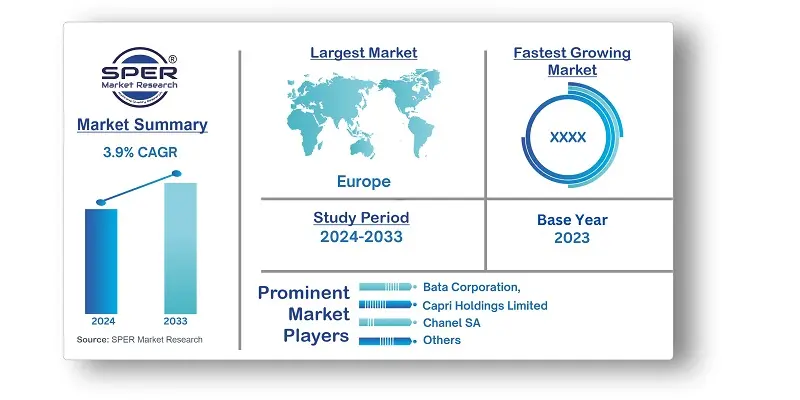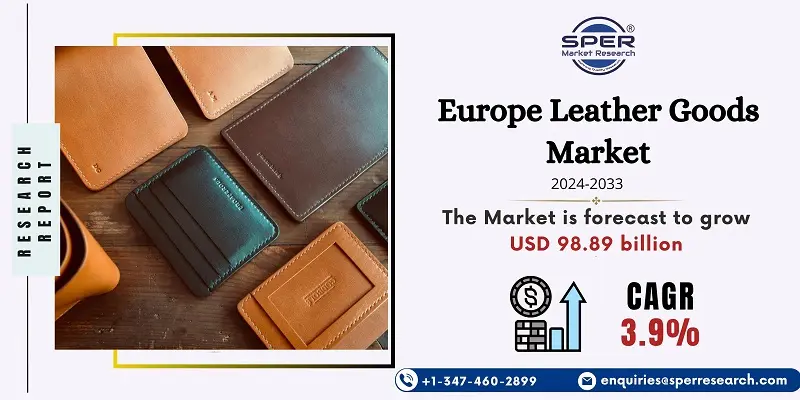
Europe Leather Goods Market Growth, Size, Trends, Demand, Share, Revenue and Future Outlook
Europe Leather Goods Market Size- By Type, By Distribution Channel- Regional Outlook, Competitive Strategies and Segment Forecast to 2033
| Published: Mar-2024 | Report ID: FMCG2472 | Pages: 1 - 152 | Formats*: |
| Category : Consumer & Retail | |||
- LVMH Métiers d'art done significant investments in Ally Projects and Robins, two well-known Italian manufacturers, in September 2022. LVMH Métiers d'art has bought high-end leather ready-to-wear manufacturer Robins and the exotic leather tannery Ally Projects. In a lengthy evolution, this is the latest investment.
- The CHANEL 22 Bag is a new bag design that Chanel introduced in January 2022. It's made of very flexible yet sturdy leather, and it's made to be lightweight and useful. Three sizes of this bag are available: small, medium, and giant.


| Report Metric | Details |
| Market size available for years | 2020-2033 |
| Base year considered | 2023 |
| Forecast period | 2024-2033 |
| Segments covered | By Type, By Distribution Channel |
| Regions covered | Germany, France, Italy, Spain, UK, Rest of Europe |
| Companies Covered | Bata Corporation, Capri Holdings Limited, Chanel SA, Hermes International SA, Kering SA, LVMH, Michael Kors Holdings Ltd, Prada SpA, Ralph Lauren Corporation, Samsonite International SA, Others. |
- Consumer Demographics
- Market Trends and Preferences
- Economic Factors
- Regulatory Environment
- Competitive Landscape
- Supply Chain Dynamics
| By Type: |
|
| By Distribution Channel: |
|
| By Region: |
|
- Europe Leather Goods Market Size (FY’2024-FY’2033)
- Overview of Europe Leather Goods Market
- Segmentation of Europe Leather Goods Market By Type (Footwear, Luggage, Accessories)
- Segmentation of Europe Leather Goods Market By Distribution Channel (Offline Retail Stores, Online Retail Stores)
- Expansion Analysis of Europe Leather Goods Market
- Problems and Obstacles in Europe Leather Goods Market
- Competitive Landscape in the Europe Leather Goods Market
- Impact of COVID-19 and Demonetization on Europe Leather Goods Market
- Details on Current Investment in Europe Leather Goods Market
- Competitive Analysis of Europe Leather Goods Market
- Prominent Players in the Europe Leather Goods Market
- SWOT Analysis of Europe Leather Goods Market
- Europe Leather Goods Market Future Outlook and Projections (FY’2024-FY’2033)
- Recommendations from Analyst
1.1. Scope of the report1.2. Market segment analysis
2.1. Research data source2.1.1. Secondary Data2.1.2. Primary Data2.1.3. SPER’s internal database2.1.4. Premium insight from KOL’s2.2. Market size estimation
2.2.1. Top-down and Bottom-up approach2.3. Data triangulation
4.1. Driver, Restraint, Opportunity and Challenges analysis4.1.1. Drivers4.1.2. Restraints4.1.3. Opportunities
4.1.4. Challenges4.2. COVID-19 Impacts of the Europe Leather Goods Market
5.1. SWOT Analysis5.1.1. Strengths5.1.2. Weaknesses5.1.3. Opportunities5.1.4. Threats5.2. PESTEL Analysis5.2.1. Political Landscape5.2.2. Economic Landscape5.2.3. Social Landscape5.2.4. Technological Landscape5.2.5. Environmental Landscape5.2.6. Legal Landscape5.3. PORTER’s Five Forces
5.3.1. Bargaining power of suppliers
5.3.2. Bargaining power of buyers5.3.3. Threat of Substitute5.3.4. Threat of new entrant5.3.5. Competitive rivalry5.4. Heat Map Analysis
6.1. Europe Leather Goods Market Manufacturing Base Distribution, Sales Area, Product Type6.2. Mergers & Acquisitions, Partnerships, Product Launch, and Collaboration in Europe Leather Goods Market
7.1. Europe Leather Goods Market Value Share and Forecast, By Type, 2024-20337.2. Footwear7.3. Luggage7.4. Accessories
8.1. Europe Leather Goods Market Value Share and Forecast, By Distribution Channel, 2024-20338.2. Offline Retail Stores8.3. Online Retail Stores
9.1. Europe Leather Goods Market Size and Market Share
10.1. Europe Leather Goods Market Size and Market Share By Type (2020-2026)10.2. Europe Leather Goods Market Size and Market Share By Type (2027-2033)
11.1. Europe Leather Goods Market Size and Market Share By Distribution Channel (2020-2026)11.2. Europe Leather Goods Market Size and Market Share By Distribution Channel (2027-2033)
12.1. Europe Leather Goods Market Size and Market Share By Region (2020-2026)12.2. Europe Leather Goods Market Size and Market Share By Region (2027-2033)12.3. Germany12.4. France12.5. Italy12.6. Spain
12.7. UK12.8. Rest of Europe
13.1. Bata Corporation13.1.1. Company details13.1.2. Financial outlook13.1.3. Product summary13.1.4. Recent developments13.2. Capri Holdings Limited13.2.1. Company details13.2.2. Financial outlook13.2.3. Product summary13.2.4. Recent developments13.3. Chanel SA13.3.1. Company details13.3.2. Financial outlook13.3.3. Product summary13.3.4. Recent developments13.4. Hermes International SA13.4.1. Company details13.4.2. Financial outlook13.4.3. Product summary13.4.4. Recent developments13.5. Kering SA13.5.1. Company details13.5.2. Financial outlook13.5.3. Product summary13.5.4. Recent developments13.6. LVMH13.6.1. Company details13.6.2. Financial outlook13.6.3. Product summary13.6.4. Recent developments13.7. Michael Kors Holdings Ltd13.7.1. Company details13.7.2. Financial outlook13.7.3. Product summary13.7.4. Recent developments13.8. Prada SpA13.8.1. Company details13.8.2. Financial outlook13.8.3. Product summary13.8.4. Recent developments13.9. Ralph Lauren Corporation13.9.1. Company details13.9.2. Financial outlook13.9.3. Product summary13.9.4. Recent developments13.10. Samsonite International SA13.10.1. Company details13.10.2. Financial outlook13.10.3. Product summary13.10.4. Recent developments
13.11. Others
SPER Market Research’s methodology uses great emphasis on primary research to ensure that the market intelligence insights are up to date, reliable and accurate. Primary interviews are done with players involved in each phase of a supply chain to analyze the market forecasting. The secondary research method is used to help you fully understand how the future markets and the spending patterns look likes.
The report is based on in-depth qualitative and quantitative analysis of the Product Market. The quantitative analysis involves the application of various projection and sampling techniques. The qualitative analysis involves primary interviews, surveys, and vendor briefings. The data gathered as a result of these processes are validated through experts opinion. Our research methodology entails an ideal mixture of primary and secondary initiatives.



Frequently Asked Questions About This Report
PLACE AN ORDER
Year End Discount
Sample Report
Pre-Purchase Inquiry
NEED CUSTOMIZATION?
Request CustomizationCALL OR EMAIL US
100% Secure Payment






Related Reports
Our Global Clients
Our data-driven insights have influenced the strategy of 200+ reputed companies across the globe.




















